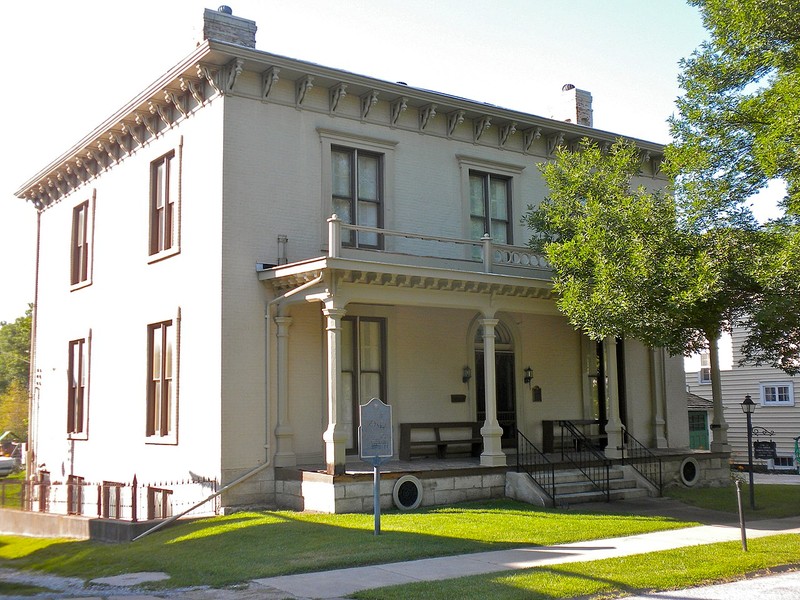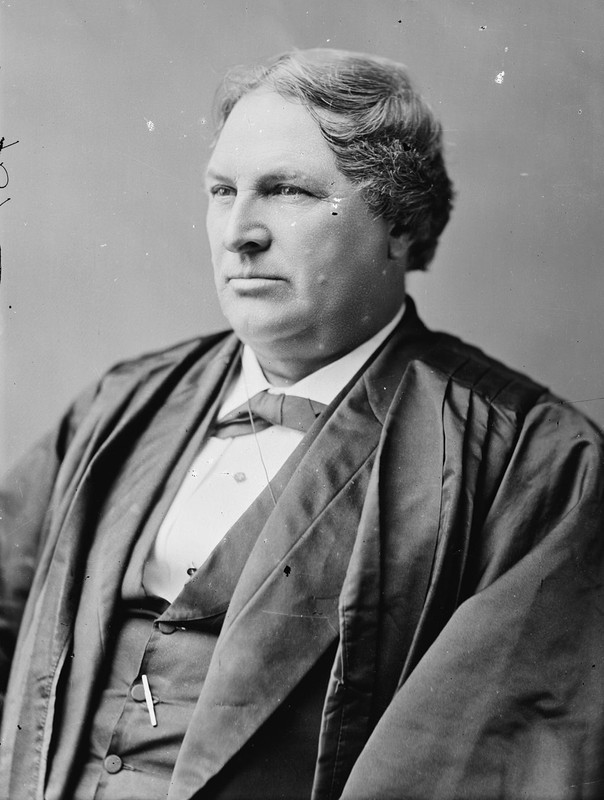Samuel F. Miller House and Museum
Introduction
Text-to-speech Audio
Owned and operated as a museum by the Lee County Historical Society, this historic home was built by U.S. Supreme Court Justice Samuel F. Miller in 1859. Miller (1816-1890), who served on the court from 1862 to 1890, was also a doctor. He is notable for being the first U.S. Supreme Court justice from west of the Mississippi River and for authoring the court's decision in the 1873 Slaughterhouse Cases (see below). Miller wrote hundreds of opinions during his 28-year tenure on the court. The house is well preserved and includes numerous historical items and furnishings including paintings of Chief Keokuk and Miller, a square grand piano, clothing, dolls, and old medical instruments. It was added to the National Register of Historic Places in 1972.
Images
The Samuel F. Miller House and Museum is operated by the Lee County Historical Society. Miller built the house in 1859.

Samuel F. Miller (1816-1890)

Backstory and Context
Text-to-speech Audio
Samuel F. Miller was born on a farm in April 5, 1816 in the town of Barbourville, Kentucky. As a young man, he attended medical school at Transylvania University, which is located in Lexington, Kentucky. He graduated in 1838 and practiced medicine for ten years. However, during that time he studied law and passed the Kentucky bar exam in 1846 (or 1847). Miller opened a practice in Barbourville and became politically active and joined the Whig Party, which was opposed to slavery. In the 1840s, the support for slavery in Kentucky increased and in 1849, the state passed a pro-slavery constitution.
These developments prompted Miller to move with his family to Keokuk in 1850. At the time, Iowa was known as a "free-soil" state, meaning that slavery was not allowed (interestingly, Miller's views on slavery apparently evolved; he owned slaves in Kentucky and freed them upon arriving in Iowa). In Keokuk, Miller opened a law practice, started to invest in real estate, and became a prominent member of the community. He helped establish the Republican Party in Iowa and ran unsuccessfully for the Iowa Senate. He also helped establish the city's first Unitarian church and eventually became the president of the church's national conference.
Miller's stature rose in Iowa's Republican Party in the 1850s and he became known outside of the state. He supported Abraham Lincoln's candidacy for president and the Union during the Civil War. In 1862, Lincoln appointed him to the U.S. Supreme Court, which had a vacancy that year. Miller supported Lincoln's use of presidential powers in the war, including the suspension of habeas corpus, which is the ability to challenge unlawful detention in court.
As noted above, Miller is best known for writing the court's decision in a case called the Slaughterhouse Cases. The ruling limited the protection of privileges and immunities granted by the 14th Amendment, which passed in 1868 and granted citizenship and equal rights to African Americans and former slaves. The case is named after slaughterhouses in New Orleans. The state of Louisiana allowed a group of slaughterhouses in New Orleans to form a corporation in 1869. The purpose was to consolidate butchering in one area and improve public health. In response, other slaughterhouses challenged the corporation in court, arguing that the state, in granting the corporation without due process of law, violated their privileges and immunities. The court ruled 5-4 in favor of the corporation. In his decision, Miller stated that the 14th Amendment's sole purpose was to protect former enslaved people and not to transfer all civil rights protections from states to the federal government.
Miller served on the court until he died from a stroke in 1890 when he was walking home from the courthouse. He is buried in Oakland Cemetery in Keokuk. Miller was married twice and had five children. He and his family lived in the house until they moved to Washington, D.C. However, they apparently retained ownership and sold it in 1881. The house remained a private residence until the Society bought it in 1965.
Sources
"About Us." Lee County Historical Society. Accessed June 20, 2021. http://home.lcihs.org/about-us.html.
Editors of Encyclopaedia Britannica. "Slaughterhouse Cases." Encyclopaedia Britannica. Last Updated by Jeff Wallendfeldt on June 25, 2010.
Miller, Benjamin K. "Miller, Samuel Freeman." The Biographical Dictionary of Iowa. Accessed December 20, 2021. http://uipress.lib.uiowa.edu/bdi/DetailsPage.aspx?id=275.
"Samuel Freeman Miller." The Historical Marker Database. Accessed December 20, 2021. https://www.hmdb.org/m.asp?m=179024. https://www.hmdb.org/m.asp?m=179024.
Talbot, William L. "Samuel Freeman Miller House." National Park Service - National Register of Historic Places Nomination Form. October 10, 1972. https://npgallery.nps.gov/NRHP/GetAsset/NRHP/72000477_text.
Wikimedia Commons: https://commons.wikimedia.org/wiki/File:Keokuk_Justice_Miller.JPG
